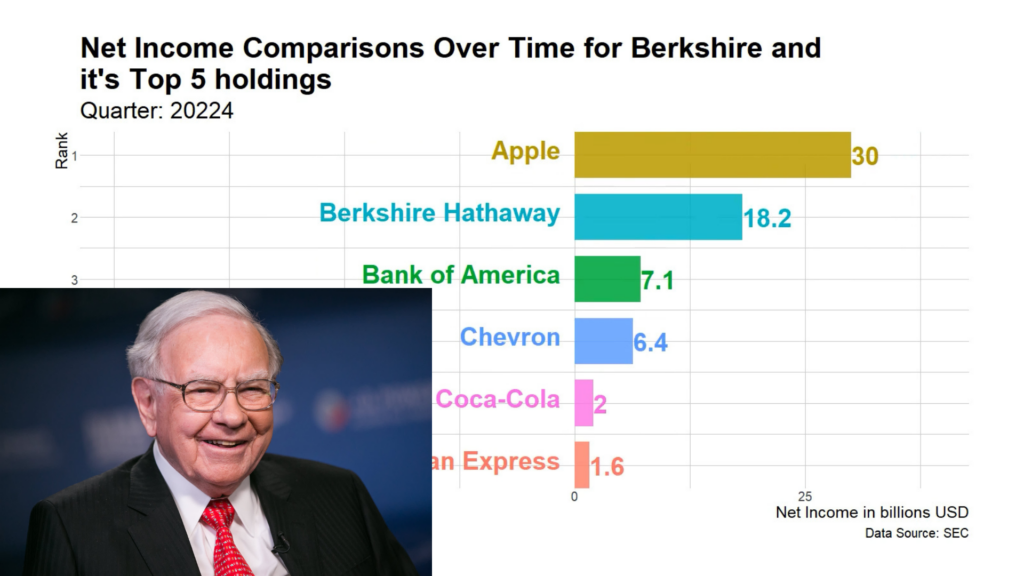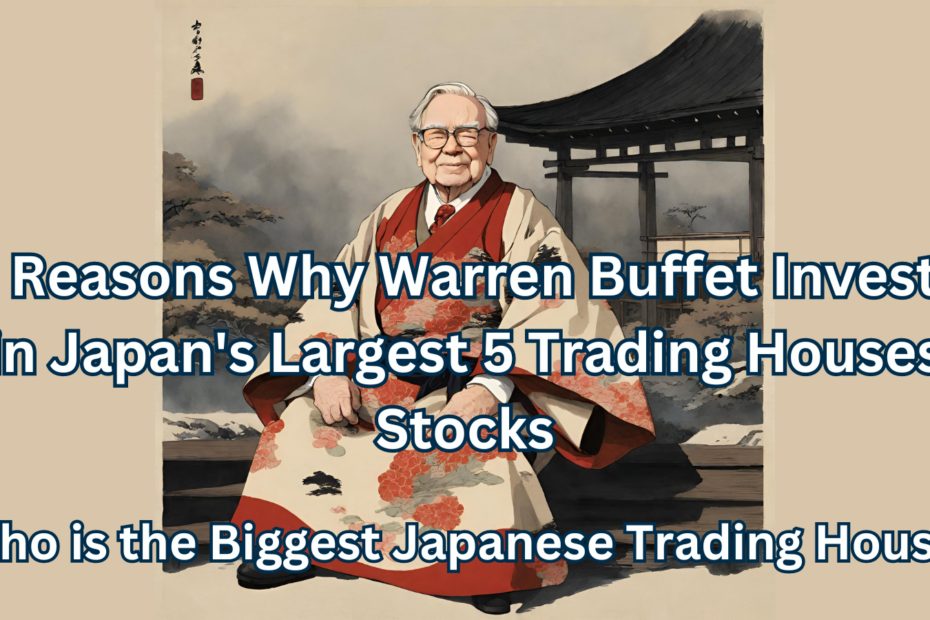Table of Contents
- 1 The Background of Buffett’s Investment in Japan’s Five Major Trading Companies Stocks
- 2 What are trading companies? What are their characteristics?
- 3 Introduction to Japan’s 5 Biggest Trading Companies
- 4 The Top 5 Reasons why Buffett invests in Japan’s 5 Major Trading Houses Stocks
- 4.1 Reason 1: Buffett believes that the five major trading houses can continue to stand firm and provide value in the next two to three decades, generating positive cash flow.
- 4.2 Reason 2: Cheap Japanese Yen
- 4.3 Reason 3: Large Company Size
- 4.4 Reason 4: Japan’s culture of unity and perseverance.
- 4.5 Reason 5: The stock prices of trading companies are significantly lower than their intrinsic value.
- 5 Which of the top five Japanese trading companies is the largest?
- 6 How to Invest in Japanese Stocks
- 7 Related Articles
The Background of Buffett’s Investment in Japan’s Five Major Trading Companies Stocks
Buffett began investing in Japan’s five major trading companies as early as August 2020. At that time, he purchased a 5% stake in each of Itochu Corporation, Marubeni Corporation, Mitsubishi Corporation, Mitsui & Co., Ltd., and Sumitomo Corporation through Berkshire Hathaway. This investment coincided with Buffett’s 90th birthday and could be seen as a birthday gift to himself, expanding the asset pools of his own company.
Buffett’s 2020 purchase of significant stakes in the top 5 Japanese trading companies marked his first major foray into the Japanese stock market. This investment decision surprised many as it differed from his typical focus on US companies.
Buffett wrote letters to the CEOs of these five trading companies, stating that Berkshire Hathaway would not purchase more than 9.9% of their shares without their CEOs’ consent. This commitment was made to assure them that there was no intention of hostile takeovers. Buffett’s investment was well-received in the Japanese business community. During his visit in April 2023, the trading company teams expressed a willingness to build trust, and discussions included the opportunity for additional investments. Buffett expressed eagerness to invest more, indicating that the larger the amount, the better. He stated his readiness to answer the phone at any time for further discussions. Naoya Okafuji, President of Itochu Corporation, remarked that Buffett’s investment affirmed the Japanese trading companies and would enhance their global visibility and influence.
One of Buffett’s main objectives during this visit was to acquire more shares in these Japanese trading companies, with hopes of surpassing a 10% stake and potentially acquiring them entirely.
Until April 2023, Buffett continued to increase his holdings in the five Japanese trading companies, raising the ownership percentage to 7.4% for each. During his two-day visit to Japan to meet with these major trading companies, Buffett had a great experience. One notable aspect was that Berkshire Hathaway financed its purchases of Japanese trading companies through yen-denominated bonds. This approach eliminated the risk associated with fluctuations in the exchange rate between the US dollar and the Japanese yen. When Berkshire Hathaway needed to repay interest and principal to bondholders for issuing yen-denominated bonds, it could use the cash dividends generated from its investments in the trading companies for payment. Since the trading companies’ cash dividends would continue to grow annually, this served as Berkshire Hathaway’s method of avoiding exchange rate risk, which was very clever. This reminded me of how the bond departments of investment banks operate, using short-term, low-interest-rate borrowings to purchase long-term, higher-interest-rate bonds, thus profiting from the interest rate differential.
Welcome to Sunfortzone, our goal is to help value investors understand more about their investments and become a better person.
If you want to grow on the path of value investing, please subscribe to our Youtube channel to get more valuable contents in the future.
Wall streets make money on activities, we, as value investors, make money on inactivities.
What are trading companies? What are their characteristics?
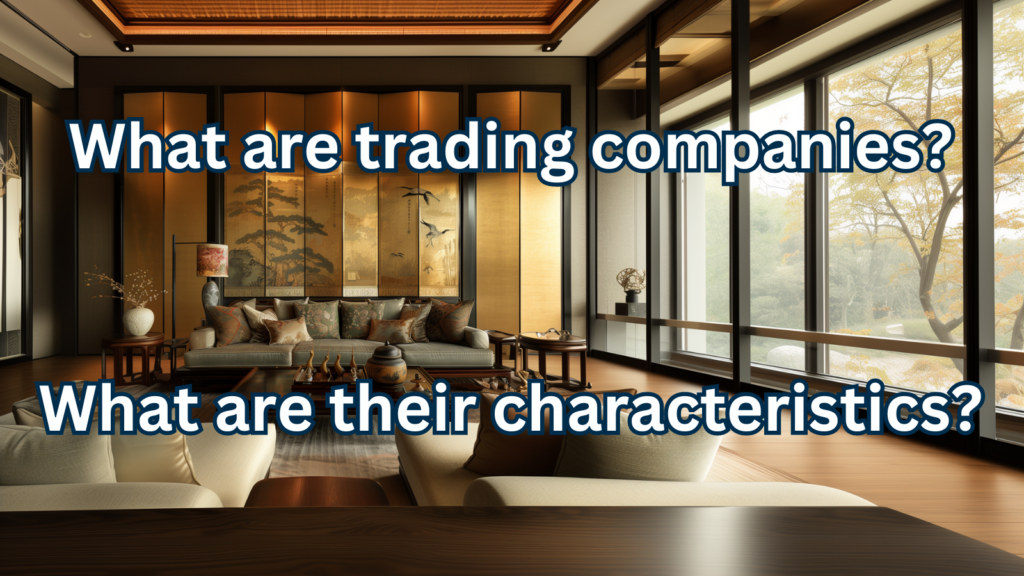
In the late period of the Tokugawa shogunate, facing the modern naval firepower of the West, the shogunate, like the Qing Dynasty, showed timidity. Concerned about the country’s path toward demise, Japan’s ambitious individuals sought to overthrow the shogunate, known as the “Tobaku” movement. You might wonder, what does this have to do with trading companies? In fact, it has a significant connection.
It is said that the earliest trading companies were established by anti-shogunate activists, with Ryoma Sakamoto being a prominent figure. They primarily engaged in commodity transportation and trade mediation, importing foreign weapons for domains such as Satsuma and Choshu, and then reselling them.
Consider Japan at that time: under the shogunate’s policy of over two hundred years of isolation, Japanese people couldn’t freely travel overseas or engage in free trade. However, with the entry of Western fleets and the collapse of the shogunate, the Meiji Restoration brought forth a new goal: “Enrich the country, strengthen the military,” embracing Westernization in all aspects. How could a small country lacking in technology and resources catch up with the Western powers? One crucial strategy was to nurture trading companies. Because after more than two centuries of isolation, it was impossible for all Japanese people to interact freely with foreigners. However, by cultivating trading companies, a portion of the population could learn and introduce advanced foreign technology, secure essential resources worldwide, and even develop markets for Japanese products. Therefore, in such a historical context, trading companies became Japan’s agents globally.
Understanding this historical background, we know that the basic business of trading companies is trading, buying and selling to earn profits in between.
Let’s think about what it takes to excel in buying and selling. First, one must have abundant sources of information. Some may think that in this era, all it takes is a quick online search, but the reality might be different. For instance, if your boss tells you that the company plans to import a thousand tons of coal next month, and the company has never made such purchases before, finding suitable suppliers becomes challenging. Coal comes in many varieties like anthracite, bituminous, and lignite. Determining which type to import, finding reliable sources in which country and from which company, and determining the minimum purchase quantity are all things a trading company needs to ensure. Without understanding the intermediary process of goods, overcoming language and business practice barriers, such transactions cannot occur.
Therefore, intermediaries in trading companies must spend time studying abroad, gaining practical knowledge of local suppliers, expanding the company’s business on their behalf, and gathering valuable intelligence. Then, on the client side, especially with resource types like these, the clients are essentially existing customers. Understanding their needs and cultivating long-term relationships is also the lifeline of trading companies. From the resource side to the client side, signing various contracts and coordinating with global logistics providers, so the second crucial ability of a trading company is its integration capability. Don’t underestimate this integration capability; these resource-type clients are essentially large existing customers. For example, why don’t steel mills bypass trading companies and directly source coal suppliers? Are these steel mills all foolish? Being taken advantage of by trading companies?
In fact, this is where the value of trading companies lies. The profit margin earned by trading companies is much lower than the cost for steel mills to organize teams to carry out these activities themselves. Moreover, trading companies can ensure the smooth progress of the entire process. Therefore, these customers continue to transact with trading companies repeatedly. Based on these transactions, how can relationships with suppliers and customers be further deepened? Business always requires funds; for example, when there’s a cash shortage or the need for more funds to expand operations, trading companies can whisper in the ear, saying that there’s some cash available. Thus, trading companies gradually extend their tentacles upward, downward, and even laterally into different industries, from raw materials, processing, manufacturing to distribution and sales, and even to after-sales services and bank loans, constructing a comprehensive network. In summary, trading companies build a complete value chain, embodying the concept of one-stop service we often hear about.
Think about it, if we combine the forces of trade and investment, the role of trading companies is truly astonishing. Moreover, do not forget, behind several major trading companies are the entire conglomerates and corporate forces. For example, if we want to invest in a factory now, trading companies can help solve all problems, from raw materials to packaging materials, even production equipment and partner factories, as well as provide funding sources. After the goods are produced, trading companies can assist with logistics and even sell them through their distribution channels. Most importantly, trading companies can also provide operators with the information and perspectives needed to make business judgments, such as market analysis and trends of industry competition and cooperation, and even the latest technologies and development directions of leading companies worldwide.
If I want to sell goods to Vietnam or Argentina, I don’t have to worry at all, because trading companies have already established a solid foundation there. Whether it’s finding partners, setting up companies, or obtaining funding, trading companies can help. Whether you need to start a factory, prepare raw materials and equipment, or expand your sales network, trading companies can handle it with ease. So, imagine, which factory has a higher chance of success: one supported by a trading company or one that is isolated? However, a factory supported by a trading company may have lower margins or less profit because these services all come at a cost.
Introduction to Japan’s 5 Biggest Trading Companies
Next, let’s introduce the five major trading companies, ranked by revenue from largest to smallest:
Mitsubishi 8058

Mitsubishi Corporation is supported by one of Japan’s three major conglomerates, the Mitsubishi Group.
It is one of the few commercial companies that can achieve a good balance between resources and non-resources. In terms of resources, it has three main business areas, including coal from Australia, liquefied natural gas, and copper.
In non-resource areas, Mitsubishi Corporation owns three major players in Japan’s supermarket industry, including Lawson, which has nearly 15,000 stores, Life supermarkets with 300 stores in the Greater Tokyo Area and Kansai Region, and 7-Eleven. Additionally, there is a lesser-known Norwegian subsidiary, Sermaq, which is one of the world’s largest salmon farming companies and also belongs to Mitsubishi Corporation.
In the automotive sector, Mitsubishi Corporation is a core enterprise of the Mitsubishi Motors Group, with numerous automobile production and sales bases worldwide. Mitsubishi Corporation is also actively investing in the development of new energy vehicles and autonomous driving technologies.
Mitsubishi Corporation is Japan’s largest general trading company and one of the largest trading companies in the world. Its business spans the globe, covering multiple fields including energy, chemicals, machinery, automobiles, food, and retail.
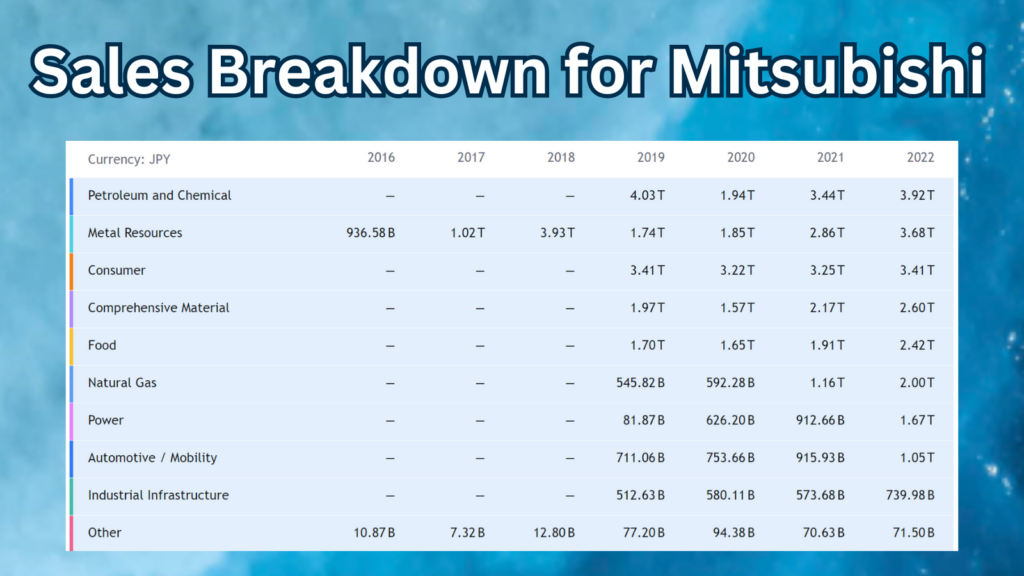
The table shows that Mitsubishi Corporation’s top three revenue components are petroleum and chemicals, metal resources, and consumer-related sectors.
The history of Mitsubishi Corporation can be traced back to the mid-19th century, founded by Yataro Iwasaki. At that time, Japan was in the midst of the Meiji Restoration, and Yataro Iwasaki saw the immense potential for Japan’s modernization. Thus, he established Mitsubishi Shokai, engaging in businesses such as coal, mining, and shipping.
Under Yataro Iwasaki’s leadership, Mitsubishi Corporation rapidly grew and became one of Japan’s most important enterprises. In the early 20th century, Mitsubishi Corporation played a significant role in Japan’s industrialization process, making important contributions to sectors such as steel, shipbuilding, and electricity.
After World War II, Mitsubishi Corporation actively participated in Japan’s reconstruction efforts and began expanding its overseas business. Today, Mitsubishi Corporation has over 200 branches worldwide and employs over 80,000 people.
Mitsubishi Corporation’s business philosophy is “Harmony, Integrity, and Pioneering Spirit,” which emphasizes conducting mutually beneficial cooperation while respecting the cultures and customs of various countries and regions. Mitsubishi Corporation has always been committed to contributing to global economic development.
Regarding future investments, Mitsubishi Corporation recently announced its business plan, which involves investing in three areas with a scale of three trillion yen. One trillion yen will be used to strengthen the revenue base, including coal, automobiles, and copper. 1.2 trillion yen will be invested in emerging energy transition businesses, including renewable energy, next-generation energy, natural gas, and copper. 0.8 trillion yen will be allocated to digital transformation businesses, strengthening AI, IoT, blockchain, and urban development.
Mitsubishi Corporation has over 80,000 employees and is headquartered in Marunouchi, Tokyo.
Itochu 8001
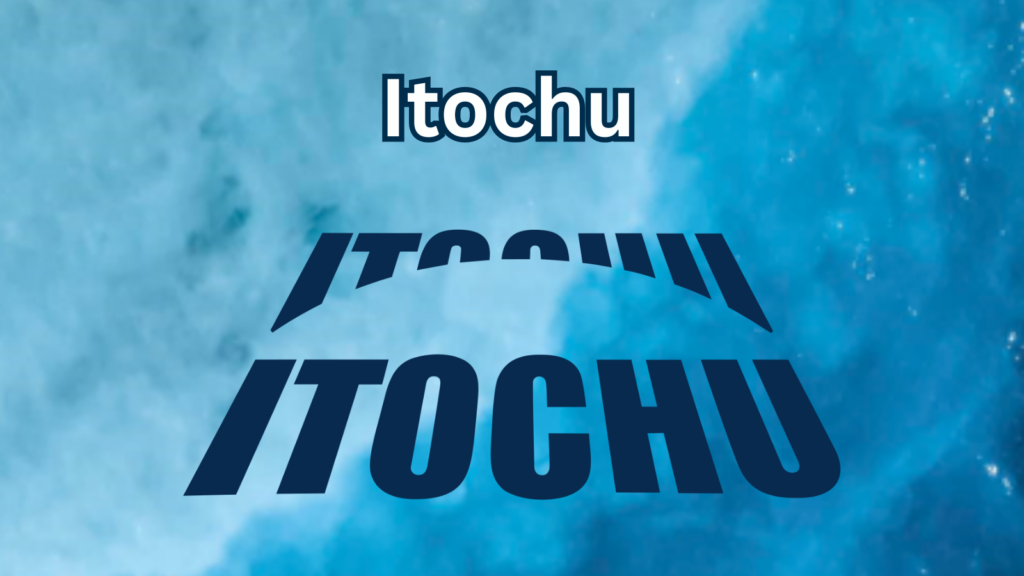
Itochu and Marubeni were once the same company. At the end of the 19th century, a merchant selling linen named Chubei Ito from Shiga Prefecture saw opportunities in foreign trade and began developing his business in Osaka. Until World War II, these two companies worked together. However, in 1949, the General Headquarters (GHQ) of the Allied Forces ordered their separation into independent companies.
GHQ, short for “General Headquarters,” was established by the Allies in Japan after World War II. General Douglas MacArthur served as the Supreme Commander. The responsibilities of GHQ included overseeing Japan’s post-war reconstruction across various aspects such as politics, economics, and military matters.
At the request of GHQ, Itochu and Marubeni were split into two independent companies in 1949. This was because GHQ believed that Japan’s zaibatsu conglomerates were too large and hindered economic development. Therefore, GHQ demanded that the Japanese government dismantle the zaibatsu and split them into smaller entities.
However, despite their shared origins, these two companies had strong competition with each other. Their relationship was often likened to water and oil until recent years, when efforts at the top level have improved it. Unlike other trading companies, Itochu’s revenue sources, with triple the profit from non-resource sectors compared to resources, are mainly focused on downstream areas near consumers. It operates FamilyMart convenience stores and various consumer goods. Itochu also collaborates with China’s CITIC Group, Thailand’s CP Group, focusing on life consumption in areas like retail, food processing, livestock, grains, healthcare, communication, and medicine.
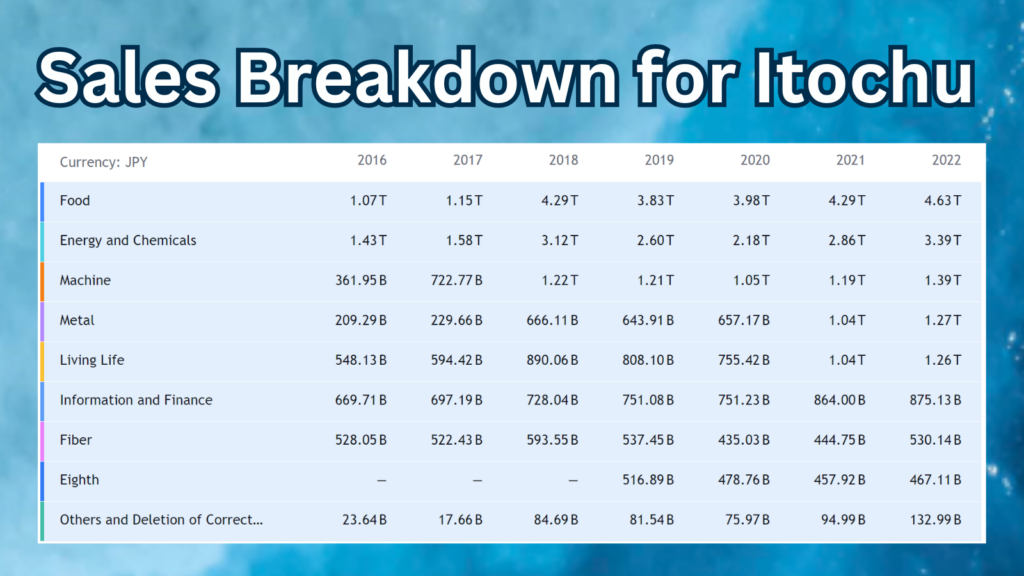
Itochu Corporation’s revenue, as seen from the table, mainly comes from food, energy and chemicals, and machinery.
Itochu has two primary growth strategies. The first is “in-market,” focusing on strengthening the product selection, convenience, and appeal of FamilyMart convenience stores, expanding customer touchpoints through advertising and financial services. The second is “sustainable development goals,” aiming to completely exit from coal trading and transitioning away from the petroleum economy toward next-generation energies like hydrogen and ammonia. They aim to build a decentralized home energy platform through household battery storage, engage in plastic recycling, and manage water and waste disposal.
Itochu has 115,000 employees and, due to historical reasons, maintains dual headquarters in Umeda, Osaka, and Kita-Aoyama, Tokyo.
Mitsui 8031

Mitsui & Co., Ltd. was established in 1876 with the support of the old Mitsui zaibatsu. Its metal resources are its strongest sector, with over half of its profits coming from metals and resources, primarily iron ore from Australia, liquefied natural gas, as well as coal and copper being major commodities. In non-energy sectors, the Mitsui Group invests mainly in food and healthcare businesses in the Asia-Pacific region.
The impression Taiwanese people have of Mitsui is most deeply associated with outlets, including those in Linkou, Taichung, and Tainan. Nowadays, when Taiwanese people mention “outlet,” they almost immediately think of Mitsui, which is the definition of leading brands.
Mitsui not only operates outlets but also another type of shopping mall called “LaLaport.” It differs somewhat from outlets as it combines shopping, dining, and entertainment in one place. In May 2023, the first LaLaport will open in the rear station area of Taichung Station. Following this, LaLaport will be established in northern Taiwan in the Nangang Software Park, while in the south, it will be in Fengshan, Kaohsiung. This means that whether in the north, central, or southern regions, LaLaport will be opening, truly blossoming everywhere.
Mitsui & Co., Ltd.’s midterm business plan has three main focuses. First, energy solutions involve investments in natural gas, social infrastructure, renewable energy, and businesses addressing climate change.
The second midterm business plan is to deepen its presence in the nutrition and healthcare field by strengthening its investment in IHH Healthcare, headquartered in Malaysia, the largest private healthcare company in Asia. This involves utilizing big data and increasing investments in healthcare products.
The third midterm business plan is to expand into the Asian market by collaborating with Indonesia’s powerful conglomerate, CT Corp, through corporate bonds, making both parties strategic partners. They hope to transform the rapid growth in Asia into a new revenue pillar and operate a broader Asian consumer lifestyle circle.
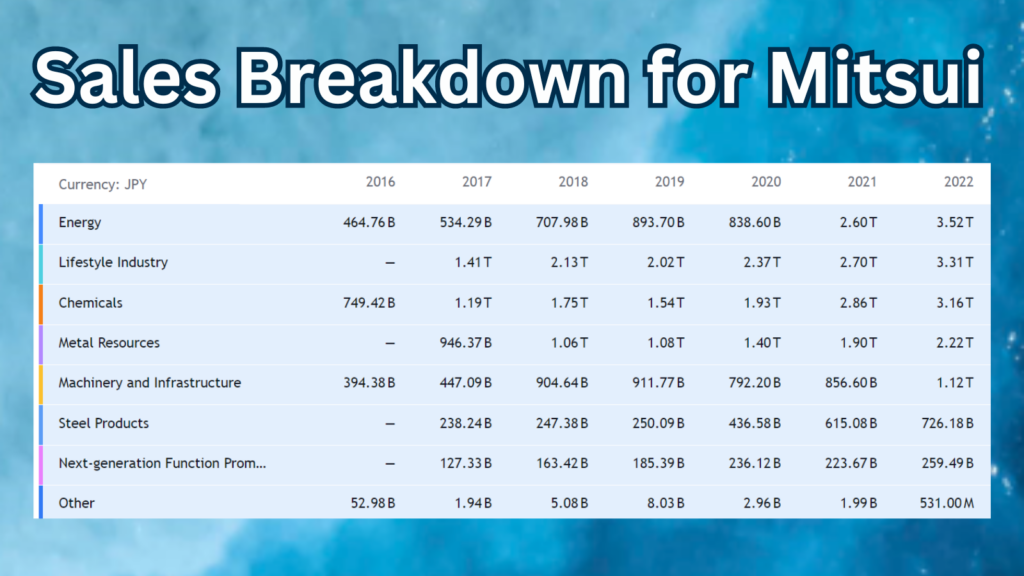
Mitsui & Co., Ltd. has its top three revenue components in energy, lifestyle, and chemicals. Lifestyle primarily refers to investments in hospitals in Malaysia.
Mitsui & Co., Ltd. has 45,000 employees and its headquarters are located in Marunouchi, Tokyo.
Marubeni 8002
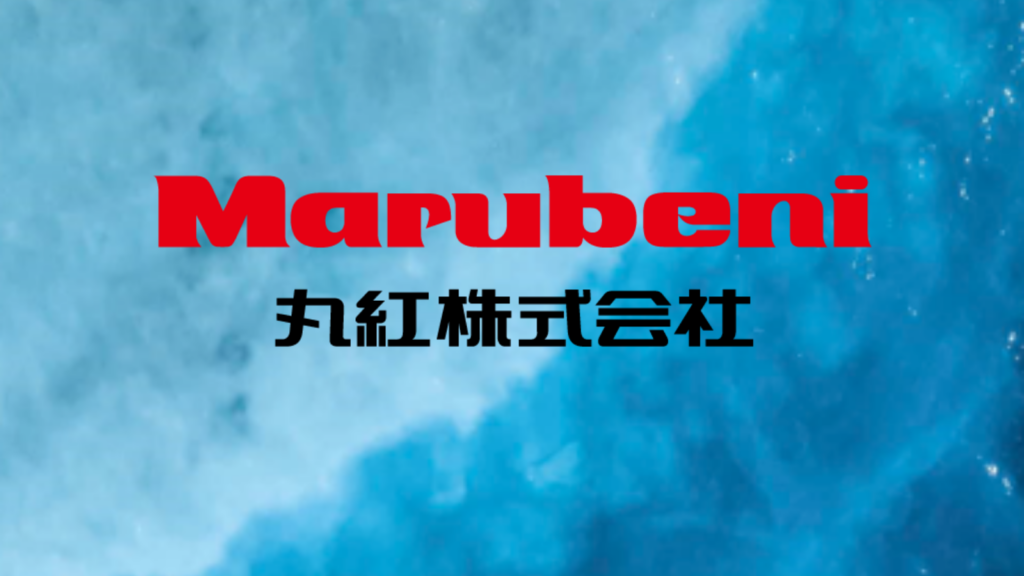
Among these commercial companies, Marubeni’s business may appear unfamiliar to most people, especially Japanese. Unlike Itochu, which focuses on directly facing consumers, Marubeni mainly concentrates on transactions between enterprises, known as B2B business.
Marubeni’s expertise lies in food ingredients and power infrastructure. They have the largest grain trading volume in Japan and also hold considerable shares in the agricultural materials sector for feed and fertilizer. Their annual grain trading volume can reach 67 million metric tons. Additionally, they command 30% of Japan’s coffee market share and 30% of the global ethylene market share. Furthermore, Marubeni owns Japan’s largest Independent Power Producer (IPP) plants, with the highest power generation capacity nationwide.
IPP, also known as Independent Power Producer, refers to power plants not operated by comprehensive electric power companies or not belonging to public utilities. In the power industry, it’s divided into three parts: generation, transmission, and distribution. If a power company operates all three parts, it’s called a comprehensive electric power company. Conversely, if it only operates power generation, it’s called an independent power producer or simply IPP.
The development of IPP mainly has several reasons:
The first reason for the development of IPP is the liberalization of the power market: In the past, the power market was usually monopolized by the government or large electric power companies. With the liberalization of the power market, private enterprises began to participate in the power market, leading to the emergence of IPP.
The second reason for the development of IPP is the advancement of power generation technology: With the advancement of power generation technology, the cost of power generation gradually decreases, making the development of IPP more favorable.
The third reason for the development of IPP is the diversification of energy structure: In order to reduce reliance on a single energy source, governments around the world have promoted the diversification of energy structures. IPP can provide diversified power generation options, thereby attracting attention from governments worldwide.
The main advantages of IPP are as follows:
The first advantage of IPP is that it can enhance the competitiveness of the power market and promote a decrease in electricity prices.
The second advantage of IPP is that it can promote the diversification of energy structures, enhancing energy security.
The third advantage of IPP is that it can create job opportunities and promote economic development.
The main disadvantages of IPP are as follows:
The first disadvantage of IPP is that it may cause excessive competition in the power market, leading to losses for power plants.
The second disadvantage of IPP is that it may affect the stability of the power system.
The third disadvantage of IPP is that it may cause environmental pollution.
Marubeni is one of Japan’s largest trading companies and has extensive experience in power infrastructure. Marubeni’s IPP (Independent Power Producer) plants are located globally, including in Japan, the United States, Europe, and Asia. These IPP plants primarily utilize methods such as thermal, natural gas, and renewable energy for power generation.
Marubeni holds Japan’s largest IPP plants, with the highest power generation capacity nationwide. Marubeni’s IPP plants have made significant contributions to Japan’s power supply.
In terms of the fiber industry, due to its relationship with Itochu, Marubeni’s fiber business is robust. However, since these businesses are relatively distant from the consumer market, although Marubeni is classified as one of the top five trading companies, in Japan, graduates aspiring to prestigious brand images often prioritize the three major Zaibatsu trading companies: Mitsubishi Corporation, Mitsui & Co., and Sumitomo Corporation.
Graduates interested in the consumer market often choose Itochu. Nevertheless, Marubeni’s allure, as revealed by its management philosophy, lies in being a company that strongly encourages challenges, diverse opinions, and innovation. In 2023, due to significant losses in large-scale investments, Marubeni emphasized capital efficiency and risk-return efficiency in its midterm plan, which is not mentioned by other trading companies. In the future, Marubeni will focus on strengthening its green businesses, including greening its overall operations.
Marubeni faced two major investment failures in 2023:
- The first setback occurred in a liquefied natural gas (LNG) export facility project in Texas, USA. Marubeni partnered with ConocoPhillips, investing a whopping $7 billion. However, due to oversupply in the global natural gas market, the project’s profitability plummeted significantly, leading Marubeni to incur massive losses.
- The second setback was in a coal mining project in Australia. Marubeni collaborated with Mitsui & Co., Ltd., a Japanese coal company, investing approximately $2 billion. Again, due to a global decline in coal demand, the project’s profitability sharply decreased, resulting in significant losses for Marubeni.
These two investment failures dealt a severe blow to Marubeni’s financial situation and exposed some issues in its investment decision-making. Therefore, in its midterm plan for 2023, Marubeni emphasized the importance of capital efficiency and risk-return efficiency, stating that it would proceed with investments more cautiously.
Marubeni’s future plans are as follows:
- Firstly, to transition towards a decarbonized society by focusing on renewable energy, natural gas, and liquefied natural gas.
- Secondly, to emphasize the circular economy, water resources, and biodiversity.
- Thirdly, to utilize Information and Communication Technology (ICT) to reduce environmental impact, including providing sustainable food ingredients.
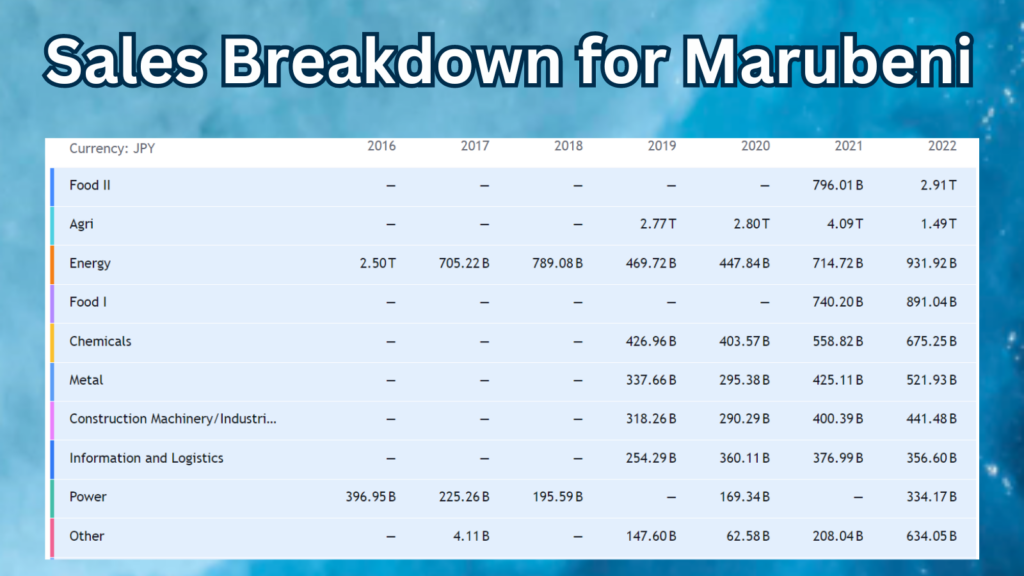
Marubeni’s top three revenue segments are bulk foods, agriculture, and energy, none of which are consumer-facing items.
Marubeni has 46,000 employees, with its headquarters located in Otemachi, Tokyo.
Sumitomo 8053

Behind Sumitomo Corporation stands one of Japan’s three major zaibatsu, the Sumitomo Group. Sumitomo’s corporate culture is highly conservative, emphasizing long-term stable profits and reputation over short-term gains. In the allocation of resources, both in energy and non-energy sectors, Sumitomo strives for balance. Among the five major trading companies, Sumitomo is most notable for its digital media and internet-related businesses.
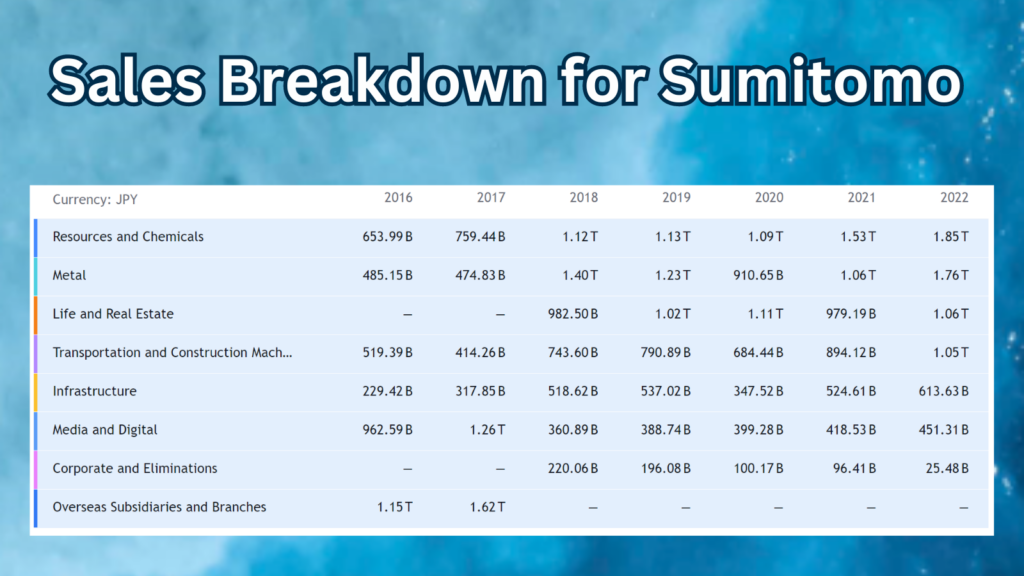
Sumitomo’s revenue primarily comes from three areas: resources and chemicals, metals, and real estate.
Sumitomo owns J:COM, Japan’s largest cable television service with a market share exceeding half, and the leading TV shopping brand, Jupiter Shop Channel. They are also actively developing digital media-related businesses like 5G.
J:COM is a telecommunications company in Japan offering cable television, broadband internet, landline, and mobile phone services. Established in 1972, the company is headquartered in Minato, Tokyo.
As a leader in cable television, J:COM has over 6 million subscribers in Japan. The company provides various channels including news, sports, entertainment, movies, and music. J:COM also offers DVR services allowing users to record and watch their favorite programs.
Regarding future investments, Sumitomo chooses to focus on further leveraging existing strengths including steel, steel pipes, media, consumer finance, and chemicals. They adjust funding through resource allocation to adapt to medium to long-term changes in future markets. Sumitomo will allocate resources into seven key businesses including domestic real estate, construction sites, civil engineering, heavy machinery leasing, overseas communications, domestic medical enterprises, renewable energy and agricultural asset sales, and related forestry and resource businesses.
Sumitomo Corporation employs 75,000 people and is headquartered in Tokyo, near the headquarters of Mitsubishi and Mitsui, located in Otemachi, north of Marunouchi.
The Top 5 Reasons why Buffett invests in Japan’s 5 Major Trading Houses Stocks
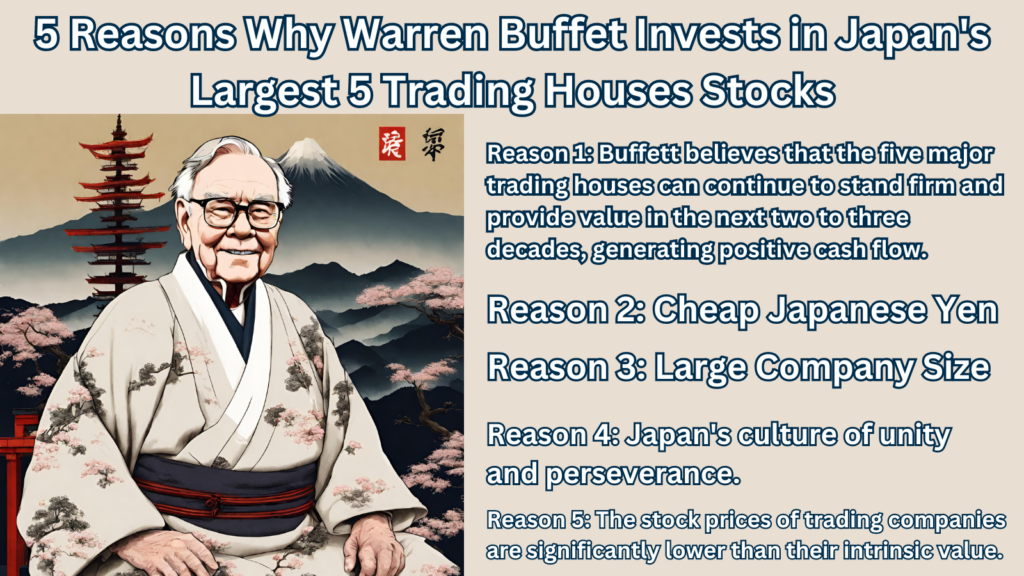
Reason 1: Buffett believes that the five major trading houses can continue to stand firm and provide value in the next two to three decades, generating positive cash flow.
The five major trading houses in Japan are all long-established century-old enterprises, with stable management teams and good profitability, which is expected to continue growing. Furthermore, Japanese trading houses have a global presence, covering various fields such as energy, resources, finance, and trade, giving them strong risk resistance capabilities.
What Buffett likes to do is basically to understand many different companies, compare different enterprises. He sees these trading houses as large companies and ones he can understand. So his idea would be to buy and hold for a long time, maybe the next two to three decades, preferably a lifetime, as long as the company’s fundamentals do not have major negative changes.
Looking at the income statements of these five trading houses over the past eight years, they have basically been profitable every year, with very stable profitability. Only Marubeni incurred losses in 2019, and Sumitomo incurred losses in 2020. The chances of the five major trading houses continuing to be profitable in the next two to three decades are high, and after purchasing the shares, excellent management talents are also provided for free.
Reason 2: Cheap Japanese Yen
Japan maintains negative interest rates at -0.1% for a long time until March 2024. The Bank of the Japan (BOJ) increased its key interest rate from -0.1% to a range of 0%-0.1%. In the past with negative interest rates, banks and central banks can borrow money without paying interest, and the central bank even pays banks an interest rate of 0.1%. Regarding mortgage interest rates, the borrowing rate for purchasing homes by individuals is approximately 1.4%, lower than Taiwan’s 2%. With interest rates so low, borrowing in Japanese yen is relatively cheap. Basically, the lower a country’s currency interest rate, the lower the cost of funds. Imagine a situation where if purchasing US Treasury bonds could yield as high as 10% interest, investors would be less inclined to buy stocks with a cash dividend yield of only 8%. Buying bonds offers a 10% return with no risk, as long as the government remains solvent. Investors would not opt for stocks with a dividend yield of only 8% and greater price volatility.
For example, Buffett bought Sumitomo at around 1300 yen in 2020, with an annual dividend of approximately 110 yen, resulting in a dividend yield of around 8%.
On September 6, 2019, Berkshire Hathaway issued yen-denominated bonds with maturities of 5, 7, 15, 20, and 30 years. The largest issuance was a 10-year bond worth 146.5 billion yen with a coupon rate of 0.44%. The coupon rates for these yen bonds ranged from 0.17% to 1.1%.
For Japanese investors facing long-term interest rates below zero, these bonds were quite attractive, leading to a rush by banks, insurers, and asset managers to invest. In comparison, the yield on Japan’s 10-year government bonds has fallen to as low as -0.245%, nearing the historical low of -0.3% in July 2016.
In summary, borrowing money to buy stocks with a Japanese yen loan costs only about 0-1%, while the return on cash dividends is around 8%, resulting in a 7% return in between, a relatively low-risk and steady investment with no exchange rate risk between the US dollar and the Japanese yen.
Reason 3: Large Company Size
With Berkshire’s current enormous scale, acquiring small-scale companies has no impact on Berkshire’s profitability, so Berkshire currently only considers purchasing relatively large enterprises.
Berkshire’s current market capitalization is approximately $888 billion US dollars, while Mitsubishi Corporation’s market capitalization is $9.2 billion US dollars. Despite being Japan’s largest trading company, Mitsubishi’s market value is only 1% of Berkshire’s market value. With Berkshire’s current cash reserves of $167.6 billion US dollars, it could easily acquire Mitsubishi outright. From Mitsubishi’s perspective, facing Berkshire is like a small shrimp facing a giant whale.
However, due to securities regulations limiting direct ownership of more than 10% of stocks, and the need to reserve cash to hedge against various risks, Berkshire is currently in the process of building trust with the management level of Japanese trading companies. It is preparing to cross the threshold of that 10% ownership limit.
Reason 4: Japan’s culture of unity and perseverance.
Japan’s culture of unity and perseverance has had a profound impact on the success of Japanese trading companies. This cultural trait enables Japanese trading companies to maintain a steadfast spirit in the face of challenges and difficulties, persistently pursuing their goals. Furthermore, Japan’s collective culture also fosters teamwork and coordination within these trading companies, allowing them to operate more efficiently.
Moreover, Japan’s culture of unity encourages trading companies to establish long-term stable relationships with suppliers and partners. Building such relationships helps trading companies ensure stable supply chains and market shares, thereby enhancing their competitiveness and chances of success.
Overall, Japan’s culture of unity and perseverance provides important support and foundation for the success of Japanese trading companies, enabling them to achieve outstanding performance in the global market.
Reason 5: The stock prices of trading companies are significantly lower than their intrinsic value.
The stock prices of Japanese trading companies have been undervalued for a long time, offering higher investment value. Buffett believes that the stock prices of Japanese trading companies are excessively cheap, especially when compared to the current low-interest-rate environment in Japan. Another point is that when Buffett bought shares of Japanese trading companies, their earnings per share divided by the stock price ratio was as high as 14%, which means the price-earnings ratio was approximately 7 times, very low. This is much cheaper compared to Taiwan Semiconductor Manufacturing Company (TSMC) with a current price-earnings ratio of approximately 22 times.
Which of the top five Japanese trading companies is the largest?
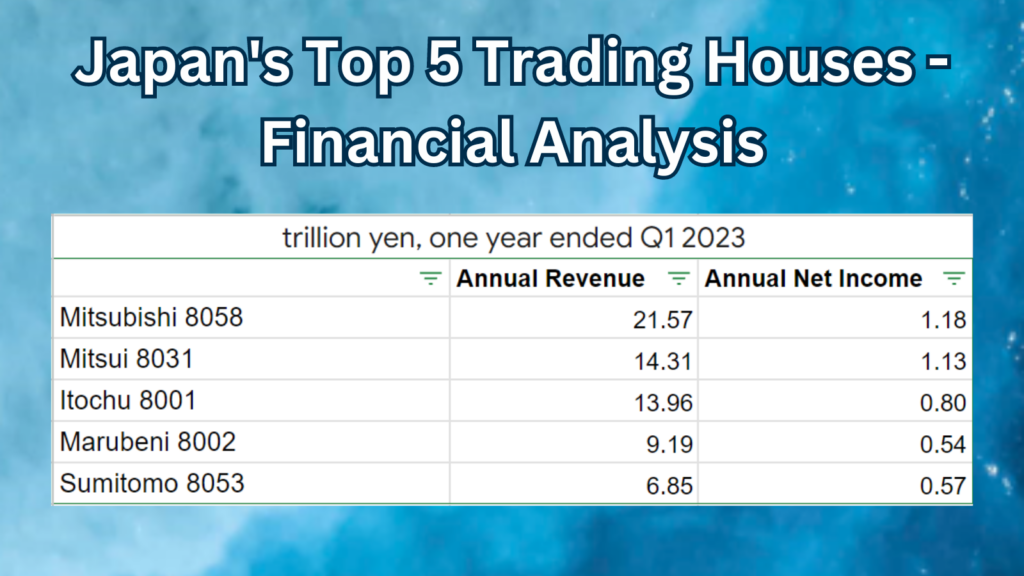
The largest Japanese trading company in terms of revenue is Mitsubishi Corporation.
Mitsubishi Corporation has the largest revenue among the top five trading companies, with a revenue of 21.57 trillion yen for the fiscal year ending in the first quarter of 2023, approximately 4.5 trillion Taiwanese dollars. Compared to TSMC’s revenue of about 2.1 trillion Taiwanese dollars in 2023, Mitsubishi’s revenue is roughly twice as large as TSMC’s.
Among the trading companies, Sumitomo Corporation has the smallest annual revenue, at 6.85 trillion yen. However, the gross profit margins of these five companies are not high, ranging from 10% to 18%. In comparison, TSMC’s gross profit margin is much higher at around 54%, which is reasonable due to its technological leadership.
In terms of profitability, the largest Japanese trading company is Mitsubishi Corporation.
Mitsubishi is the largest in terms of both profit and revenue among the five trading companies. Mitsubishi’s net profit for the fiscal year ending in the first quarter of 2023 was 1.18 trillion yen, approximately 250 billion Taiwanese dollars, with a net profit margin of 5.4%. In contrast, TSMC’s net profit in 2023 was about 830 billion Taiwanese dollars. Therefore, despite Mitsubishi having a larger revenue than TSMC, TSMC’s net profit, driven by its technological advantage, is more than three times that of Mitsubishi.
In terms of brand influence, the largest Japanese trading company is Mitsubishi Corporation.
Mitsubishi Corporation is Japan’s largest general trading company and is also one of the Fortune Global 500 companies. Its brand influence is highly regarded globally, with well-known brands under Mitsubishi including convenience store Lawson, Life supermarkets, 7-Eleven, salmon farming company Cermaq, Mitsubishi UFJ Financial Group (Japan’s largest bank), Mitsubishi Motors, Mitsubishi Heavy Industries, Nikon (camera company), and more.
Basically, if a company directly facing consumers can make customers happy with its products or services, it can establish a strong brand and reputation in the market, which is conducive to continued revenue growth.
How to Invest in Japanese Stocks
Taiwanese investors have options for investing in Japanese stocks through sub-brokerage or overseas brokers. For sub-brokerage, the known options for investing in Japanese stocks include Sinopac, Fubon, Yuanta, and KGI, while overseas brokers include Interactive Brokers. For Taiwanese investors using Interactive Brokers to buy Japanese stocks, they need to have Japanese yen in their cash accounts. Within Interactive Brokers, they can directly exchange US dollars for Japanese yen.
Introduction to Interactive Brokers (IBKR)
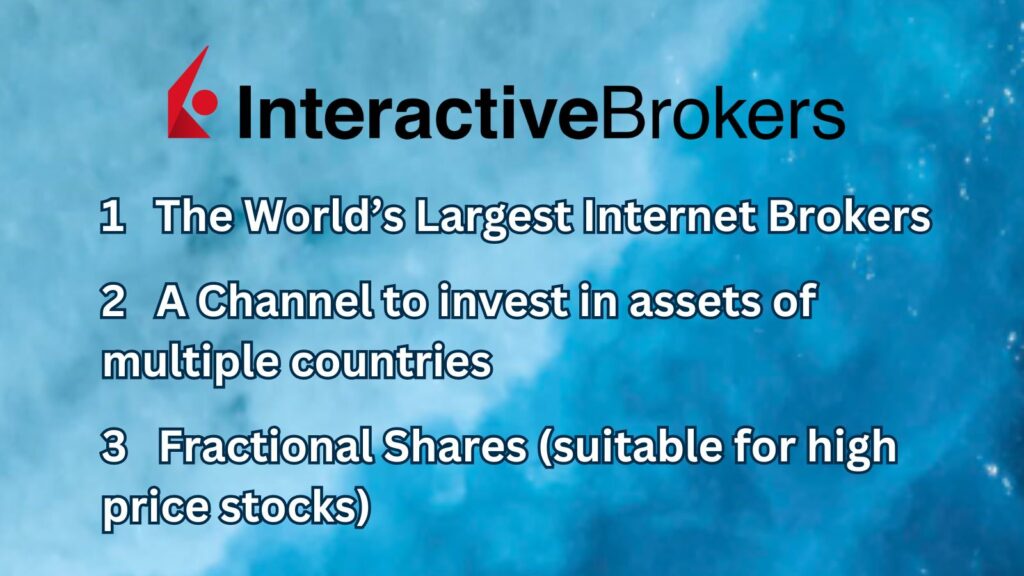
Here, we introduce a high-quality US stock brokerage called Interactive Brokers, which we primarily use as a channel for investing in US stocks.
Interactive Brokers has three main advantages. First, it was established in 1978 and is the world’s largest online brokerage. Its ticker symbol on the US Nasdaq stock exchange is IBKR. It is listed on the Nasdaq with a market capitalization of approximately $8.7 billion USD. If you check its profitability on our website, go to the Stock Analysis page at Sunfortzone.com, search for IBKR, you can see that Interactive Brokers’ quarterly net profits are positive and in a growing trend, indicating very low risk of bankruptcy.
Second, Interactive Brokers allows investment in a wider variety of assets. As a global brokerage, Interactive Brokers enables the purchase of stocks worldwide, including countries such as the United States, China, Japan, Germany, France, Canada, Australia, Italy, and more. Regarding ETFs, Interactive Brokers offers a diverse selection, such as TQQQ, a triple-leveraged Nasdaq ETF.
Third, Interactive Brokers allows fractional share purchases, meaning you can buy units smaller than one whole share. This is suitable for high-priced stocks like Berkshire Hathaway, which trades at around $600,000 per share. With Interactive Brokers, you can invest a specific amount of money without having to buy a whole share. For example, you can set to buy $100 worth of Berkshire Hathaway shares. The drawback of fractional shares is that they do not come with voting rights, but you can still receive dividends from fractional shares.

Here at Sunfortzone, we provide an exclusive account opening offer link for Interactive Brokers. For every $100 US dollars deposited, you can receive $1 US dollars worth of IBKR stock, with a maximum value of $1,000 US dollars IBKR stock!
We strongly recommend our friends who are serious about their investments to open an account, deposit over $10,000 US dollars within 30 days, and invest in good, undervalued stocks at the right time, holding them for at least a year.
As Warren Buffett said, one crucial aspect of investing is to start early. Buffett bought his first stock at around the age of ten and continuously accumulated wealth like a rolling snowball, leading to his current achievements, emphasizing the importance of continuous learning and growth.
How to Add Japanese Trading Companies Stocks to Your Watchlist in IB Interactive Brokers
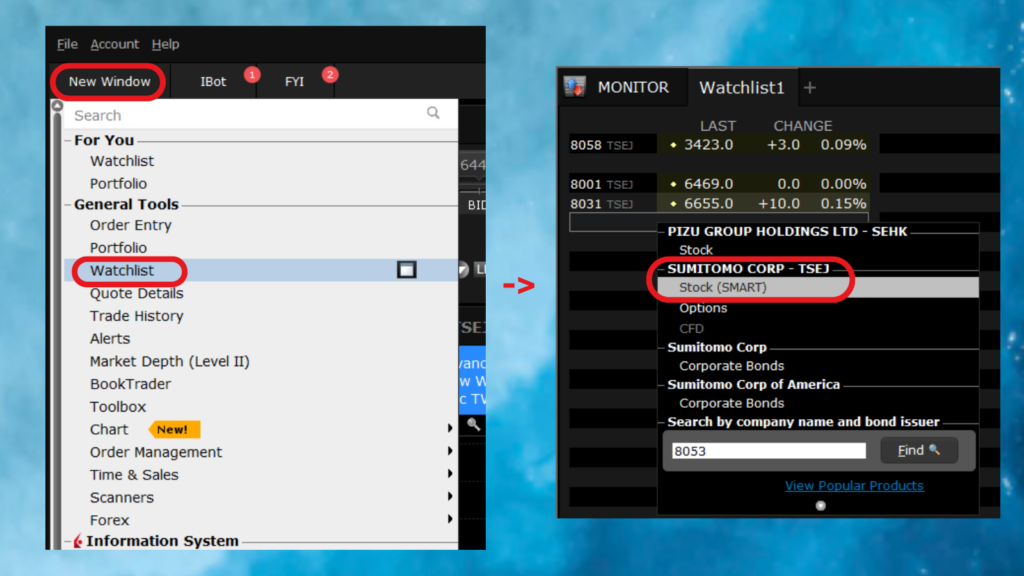
To add the five trading companies to your watchlist on IB, first log in to the IB desktop version program, Trader Workstation. Click on “New Window” in the top left corner, select “Watchlist,” and a new window will open. Then, enter the codes of the five trading companies one by one, specifically, 8058, 8001, 8031, 8002, 8053, and press Enter. A small window will pop up to select the stock, and make sure the exchange is TSEJ.
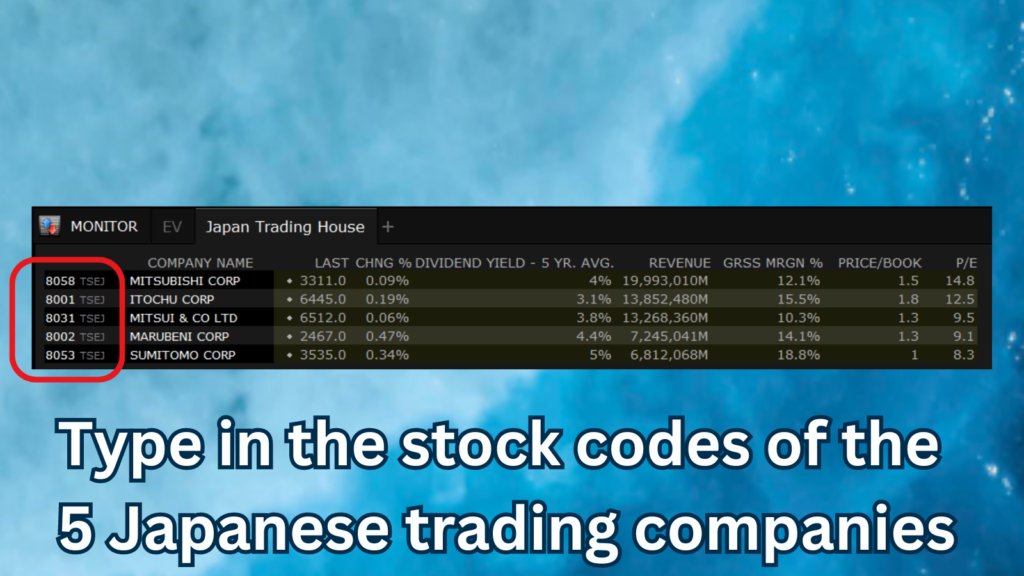
After adding the five trading companies to your watchlist, you can also add many fundamental columns. Refer to this table, and add columns such as stock price, daily returns change percentage, cash dividend yield, revenue scale, gross profit margin, price-to-book ratio, and price-to-earnings ratio, which are helpful for understanding the financial aspects of each company.
The above is a tutorial for the Windows desktop version of the program. In fact, IB’s mobile version can also add stocks to your watchlist, with similar methods.
Step by Step Tutorial on Purchasing Japanese Stocks with Interactive Brokers
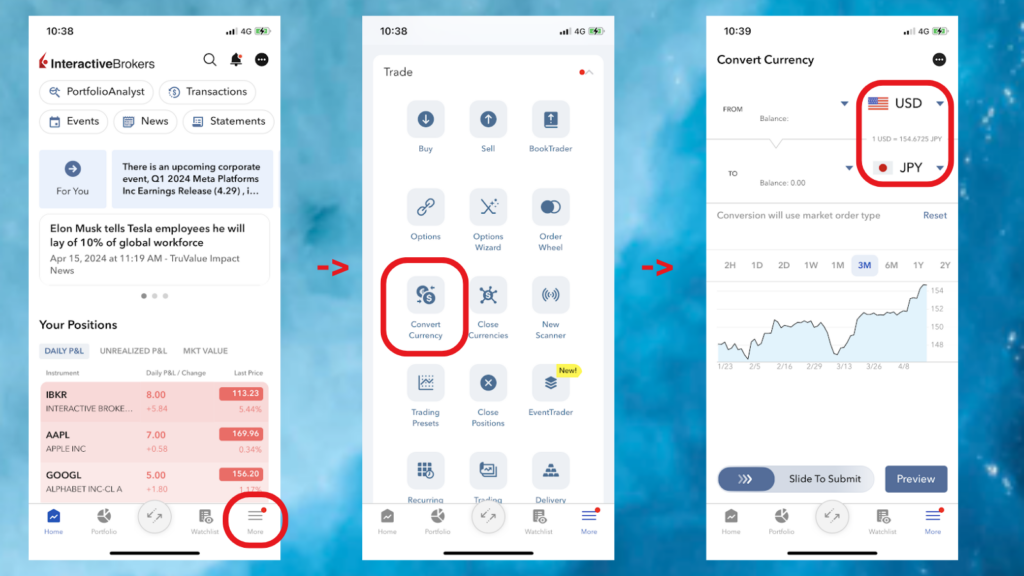
This time, we will teach you how to buy Japanese stocks with the IB mobile app. First, you should have US dollars. Open the IB mobile app, click on “Convert” on the home page, and you can exchange US dollars for Japanese yen within IB, which is very convenient.

Next, go to the watchlist of the five trading companies, and you can buy the stocks of the trading companies you like.
Thanks for spending your valuable time with us! If you like our content, please like and subscribe to our Youtube channel to get more valuable content.
Furthermore, please visit our website sunfortzone.com for more data-driven insights, and join our Discord Server to discuss with other investors.
If you’ve learned something from our productions, please check out the Interactive Brokers webpage and click the inclusive link down below to open an account for free. Your actions means a world to us!

What’s your idea? please leave a comment below! We would like to learn something from you as well!
Related Articles

Warren Buffett shares how they choose businesses to invest in and the philosophy behind it.

5 Key Takeaways from The Intelligent Investor by Benjamin Graham
